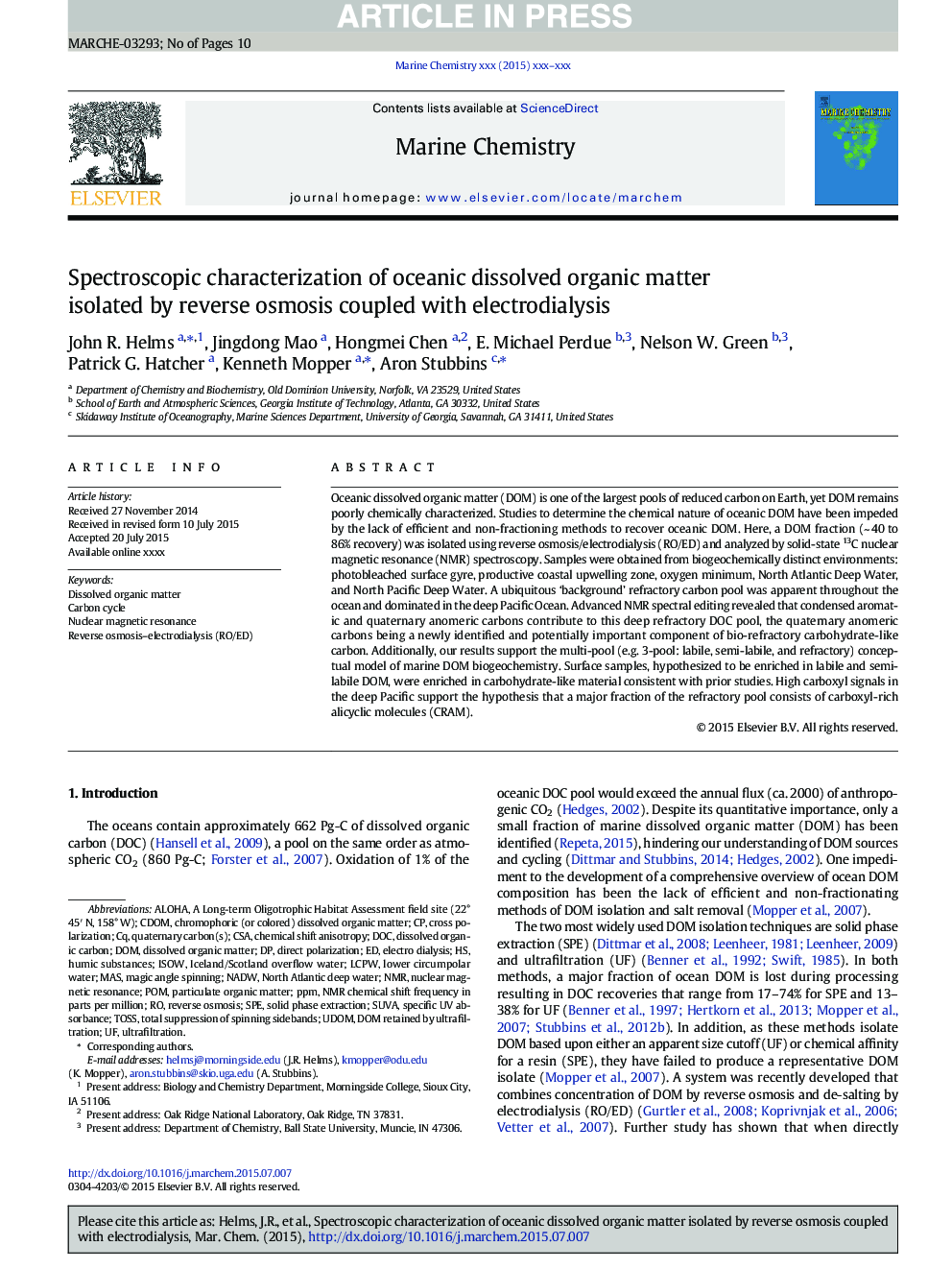| کد مقاله | کد نشریه | سال انتشار | مقاله انگلیسی | نسخه تمام متن |
|---|---|---|---|---|
| 10565646 | 971774 | 2015 | 10 صفحه PDF | دانلود رایگان |
عنوان انگلیسی مقاله ISI
Spectroscopic characterization of oceanic dissolved organic matter isolated by reverse osmosis coupled with electrodialysis
ترجمه فارسی عنوان
خصوصیات اسپکتروسکوپی مواد آلی محلول اقیانوسی جدا شده توسط اسمز معکوس همراه با الکترودیلیز
دانلود مقاله + سفارش ترجمه
دانلود مقاله ISI انگلیسی
رایگان برای ایرانیان
کلمات کلیدی
SUVAppmCDOMDOCTOSSPOMSpecific UV absorbanceNADWSPEnuclear magnetic resonance - رزونانس مغناطیسی هستهایChemical shift anisotropy - Anisotropy شبیه سازی شیمیاییNorth Atlantic Deep Water - آبهای عمیق شمال آتلانتیکSolid phase extraction - استخراج فاز جامدReverse Osmosis - اسمز معکوسAloha - الههUltrafiltration - اولترافیلتراسیونCSA - ایالات مؤتلفهٔ آمریکاMAS - بیشترNMR - تشدید مغناطیسی هستهای magic angle spinning - زاویه جادویی چرخشDOM - قضاوتdirect polarization - قطبش مستقیمParticulate organic matter - ماده آلی آلیDissolved organic matter - ماده آلی حل شدهHumic substances - مواد هیومیکیCross polarization - پلاریزه شدن صلیبCarbon cycle - چرحه کربن Dissolved organic carbon - کربن آلی حل شده
موضوعات مرتبط
مهندسی و علوم پایه
شیمی
شیمی (عمومی)
چکیده انگلیسی
Oceanic dissolved organic matter (DOM) is one of the largest pools of reduced carbon on Earth, yet DOM remains poorly chemically characterized. Studies to determine the chemical nature of oceanic DOM have been impeded by the lack of efficient and non-fractioning methods to recover oceanic DOM. Here, a DOM fraction (~Â 40 to 86% recovery) was isolated using reverse osmosis/electrodialysis (RO/ED) and analyzed by solid-state 13C nuclear magnetic resonance (NMR) spectroscopy. Samples were obtained from biogeochemically distinct environments: photobleached surface gyre, productive coastal upwelling zone, oxygen minimum, North Atlantic Deep Water, and North Pacific Deep Water. A ubiquitous 'background' refractory carbon pool was apparent throughout the ocean and dominated in the deep Pacific Ocean. Advanced NMR spectral editing revealed that condensed aromatic and quaternary anomeric carbons contribute to this deep refractory DOC pool, the quaternary anomeric carbons being a newly identified and potentially important component of bio-refractory carbohydrate-like carbon. Additionally, our results support the multi-pool (e.g. 3-pool: labile, semi-labile, and refractory) conceptual model of marine DOM biogeochemistry. Surface samples, hypothesized to be enriched in labile and semi-labile DOM, were enriched in carbohydrate-like material consistent with prior studies. High carboxyl signals in the deep Pacific support the hypothesis that a major fraction of the refractory pool consists of carboxyl-rich alicyclic molecules (CRAM).
ناشر
Database: Elsevier - ScienceDirect (ساینس دایرکت)
Journal: Marine Chemistry - Volume 177, Part 2, 20 December 2015, Pages 278-287
Journal: Marine Chemistry - Volume 177, Part 2, 20 December 2015, Pages 278-287
نویسندگان
John R. Helms, Jingdong Mao, Hongmei Chen, E. Michael Perdue, Nelson W. Green, Patrick G. Hatcher, Kenneth Mopper, Aron Stubbins,
